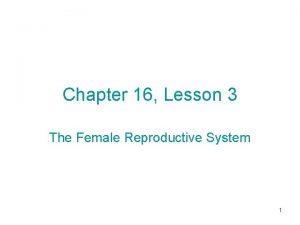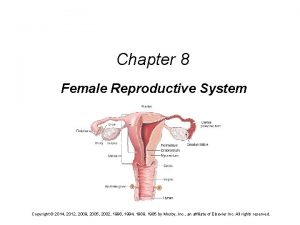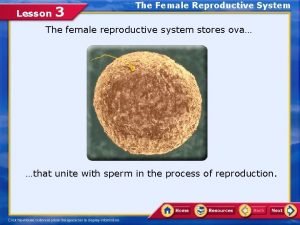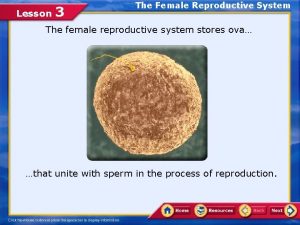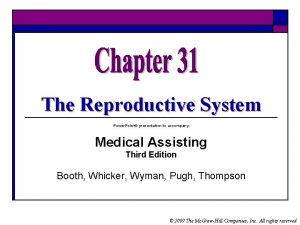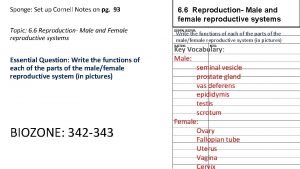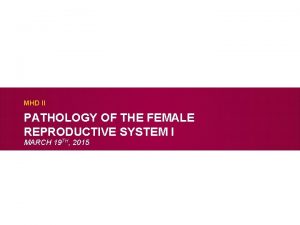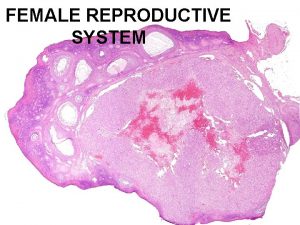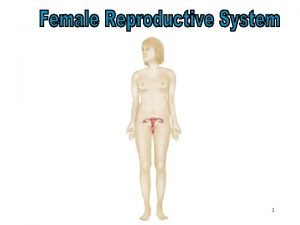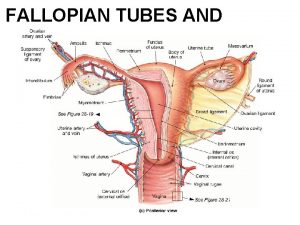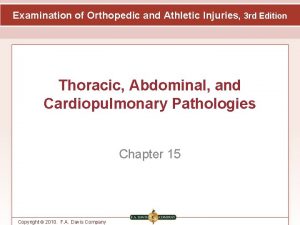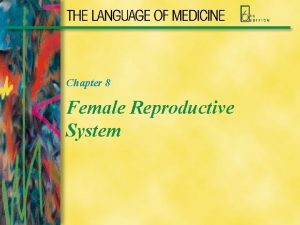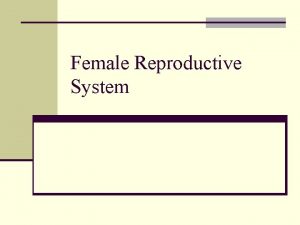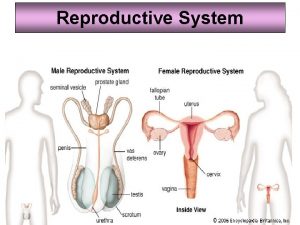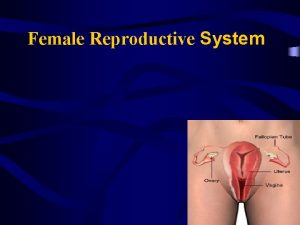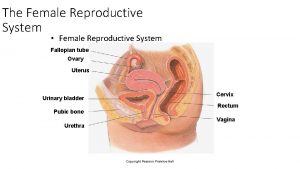Chapter 15 The Female Reproductive System Normal Female








































- Slides: 40

Chapter 15 The Female Reproductive System

Normal Female Reproductive System From Applegate EJ: The Anatomy and Physiology Learning System: Textbook. Philadelphia, WB Saunders, 1995. Figure 15 -01

The Hypothalamic-Pituitary-Ovarian Axis From Applegate EJ: The Anatomy and Physiology Learning System: Textbook. Philadelphia, WB Saunders, 1995. Figure 15 -02

Overview of Major Diseases • • Infections Hormonal disorders Benign and malignant tumors Disorders related to pregnancy

Normal Menstrual Cycle From Applegate EJ: The Anatomy and Physiology Learning System: Textbook. Philadelphia, WB Saunders, 1995. Figure 15 -03 A

Normal Menstrual Cycle From Applegate EJ: The Anatomy and Physiology Learning System: Textbook. Philadelphia, WB Saunders, 1995. Figure 15 -03 B

Inflammatory Diseases Figure 15 -04

Inflammatory Diseases—Classification • Anatomic classification (e. g. , vulvitis, vaginitis, cervicitis, endometritis, salpingitis) • Chronologic—acute, chronic • Pathogenetic—ascending, descending • Etiologic—viral, bacterial, chlamydial, fungal, protozoal

Common Genital Infections • • • Genital herpes Human papillomavirus (HPV) infection Chlamydial infection Gonorrhea Syphilis

Hormonally Induced Lesions • Anovulatory cycle – Anorexia nervosa – Early menopause • Endometrial hyperplasia – Cystic – Adenomatous simple – Adenomatous complex – Adenomatous with atypia

Endometrial Hyperplasia in Hyperestrinism Figure 15 -05

Tumors of the Female Reproductive System—General Facts • 15% of all malignant tumors and 10% of all cancer deaths in women • 70, 000 new cases per year and 23, 000 deaths • Benign tumors more common—for every malignant tumor, there approximately five benign tumors

Estimated New Cases and Number of Deaths Related to Gynecologic Tumors Table 15 -2

Carcinoma of the Cervix • Related to human papillomavirus infection • Preceded by CIN (dysplasia progressing to carcinoma in situ and invasive carcinoma) • Histologically—squamous cell carcinoma • Early detection by Pap smear • Variable prognosis—depends on the stage of the tumor

Staging of Carcinoma of the Cervix Figure 15 -07

Tumors of the Uterus • Myometrial tumors – Leiomyoma (benign, common) – Leiomyosarcoma (malignant, rare) • Endometrial tumors – Adenocarcinoma (malignant, common) _________________ Note: All endometrial tumors are malignant— there are no adenomas!

Endometrial Adenocarcinoma • Related to hyperestrinism • May be preceded by endometrial hyperplasia • Occurs in perimenopausal and postmenopausal (older) women • Histologically—adenocarcinoma • Variable prognosis—depends on the stage and to a lesser extent on the grade of the tumor

Endometrial Adenocarcinoma Figure 15 -08

Staging of Endometrial Carcinoma Figure 15 -09

Leiomyoma of the Uterus Figure 15 -10

Leiomyoma of the Uterus Figure 15 -11

Endometriosis • Foci of endometrium found outside the uterus • Most often located on the ovary and pelvic peritoneum • Very common disease, clinically causing: – Cyclic pain – Infertility

Ovarian Cysts • Solitary – Follicular cyst – Corpus luteum cyst • Multiple – Polycystic ovary syndrome (POS)—associated with hormonal disturbances, menstrual irregularities, hirsutism, infertility

Ovarian Neoplasm • • • Tumors of the surface epithelium (70%) Tumors of germ cells (20%) Tumors of the sex cord stromal cells (10%) Nonspecific tumors of ovarian stroma Metastases from tumor of other organs

Ovarian Surface Epithelial Tumors Benign Borderline Malignant Serous cystadenoma Serous tumor of borderline malignancy Mucinous tumor of borderline malignancy Serous cystadenocarcinoma Mucinous cystadenocarcinoma Endometrioid adenocarcinoma

Serous Cystadenocarcinoma Figure 15 -13 A

Serous Cystadenocarcinoma Figure 15 -13 B

Mucinous Cystadenoma Figure 15 -14 A

Mucinous Cystadenoma Figure 15 -14 B

Germ Cell Tumor of the Ovary • This tumor is found predominantly in women younger than age 25. • Teratoma, the most common germ cell tumor, is benign. • Malignant tumors (teratocarcinomas) may secrete AFP and h. CG.

Sex Cord Stromal Tumors • Granulosa cell tumor • Thecomas • Sertoli-Leydig cell tumor

Metastases to the Ovaries • Krukenberg tumors—metastases most often from stomach but may also be from intestinal adenocarcinomas • Breast carcinoma

Pathology of Fertilization • • Ovum-related factors Sperm-related factors Genital organs–related factors Systemic factors

Pathology of Implantation • Ectopic pregnancy

Ectopic Pregnancy Figure 15 -15

Pathology of Placentation • Placenta accreta • Placenta previa

Abortion • Induced • Spontaneous – Complete – Incomplete – Missed abortion – Threatened abortion

Gestational Trophoblastic Disease • Hydatidiform mole – Complete mole—androgenesis – Incomplete mole—polyspermia • Choriocarcinoma – In 50%, develops from hydatidiform mole – In 25%, develops from placental cells after abortion – In 25%, develops from normal placenta

Hydatidiform Mole Figure 15 -16

Toxemia of Pregnancy • Preeclampsia—triad of hypertension, edema, and proteinuria • Eclampsia—all of the above plus seizures _________________ Note: Common! • Found in 6% of pregnancies; usually mild. • More common in primarius women than in later pregnancies.
 Female reproductive system
Female reproductive system Female organs
Female organs Chapter 8 female reproductive system
Chapter 8 female reproductive system Chapter 16 lesson 3 the female reproductive system
Chapter 16 lesson 3 the female reproductive system Male and female reproductive system
Male and female reproductive system Female reproductive system with baby
Female reproductive system with baby Female anatomy diagram
Female anatomy diagram Female reproductive system pregnancy
Female reproductive system pregnancy Female and male reproductive system
Female and male reproductive system Lesson 3 the female reproductive system
Lesson 3 the female reproductive system Ligaments of female reproductive system
Ligaments of female reproductive system Renal
Renal Fertilization in pila
Fertilization in pila Uterus pig
Uterus pig Figure 28-1 the male reproductive system
Figure 28-1 the male reproductive system Infindibulum
Infindibulum Female cow reproductive system
Female cow reproductive system Reproductive system of male cattle
Reproductive system of male cattle Similarities between male and female reproductive system
Similarities between male and female reproductive system Sperm duct
Sperm duct Male reproductive system diagram
Male reproductive system diagram Plot
Plot What are primary sexual characteristics
What are primary sexual characteristics Corpus luteum in female reproductive system
Corpus luteum in female reproductive system Lesson 3 the female reproductive system
Lesson 3 the female reproductive system Female reproductive system color
Female reproductive system color Female reproductive system external
Female reproductive system external 90/2
90/2 Conclusion of female reproductive system
Conclusion of female reproductive system Prostatic urethra male
Prostatic urethra male Female reproductive system pathology
Female reproductive system pathology Male reproductive system labeled
Male reproductive system labeled Cow reproductive anatomy
Cow reproductive anatomy Female reproductive system pathology
Female reproductive system pathology Female reproductive system pathology
Female reproductive system pathology Female reproductive system
Female reproductive system Abortion types
Abortion types Female reproductive system pathology
Female reproductive system pathology Bovine female reproductive system
Bovine female reproductive system Falopian tube parts
Falopian tube parts Female reproductive system pathology
Female reproductive system pathology

